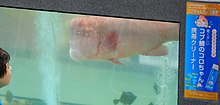

| Asian sheepshead wrasse | |
|---|---|

| |
| Scientific classification | |
| Domain: | Eukaryota |
| Kingdom: | Animalia |
| Phylum: | Chordata |
| Class: | Actinopterygii |
| Order: | Labriformes |
| Family: | Labridae |
| Genus: | Semicossyphus |
| Species: |
S. reticulatus
|
| Binomial name | |
| Semicossyphus reticulatus (Valenciennes, 1839) | |
| Synonyms | |
| |
The Asian sheepshead wrasse (Semicossyphus reticulatus) is one of the largest species of wrasse.[2] Native to the western Pacific Ocean, it inhabits rocky reef areas around the Korean Peninsula, China, Japan, and the Ogasawara Islands.[2][1] It can reach 100 cm (39 in) in total length and the greatest weight recorded for this species is 14.7 kg (32 lb).[2] This species is valued for its sweet, shellfish-like taste.[1]

The Asian sheepshead wrasse, also known as the kobudai in Japan, is a hermaphroditic species, meaning that it has both male and female organs which allows it to change its sex. All Sheepshead are born female and as they grow older, eventually will change sex. The species gained media attention when the transformation was caught on camera by the BBC Earth crew while filming in the waters near Sado Island, Japan. In 2017, it was shown on the Blue Planet II episode "One Ocean".[3]
According to Great Big Story, Japanese diver Hiroyuki Arakawa has had a 30-year relationship with a sheepshead wrasse in Japan's Tateyama Bay, where he is the caretaker for an underwater Shinto shrine. He calls the fish, named "Yoriko", by hitting a bell on the underwater shrine.[4]
| Semicossyphus reticulatus |
|
|---|---|
This Labridae article is a stub. You can help Wikipedia by expanding it. |